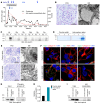No abstract available
Keywords:
Autoimmune diseases; Autoimmunity; Nephrology.
PubMed Disclaimer
Conflict of interest statement
Conflict of interest: FEH, TBH and NMT report a pending patent regarding the measurement of anti-nephrin antibodies (patent number 1878 LU). TBH and NMT received funding from Euroimmun AG for assay development.
References
-
-
Hengel FE, et al. Autoantibodies targeting nephrin in podocytopathies. N Engl J Med. 2024;391(5):422–433. doi: 10.1056/NEJMoa2314471.
-
DOI
-
PubMed
-
-
Watts AJB, et al. Discovery of autoantibodies targeting nephrin in minimal change disease supports a novel autoimmune etiology. J Am Soc Nephrol. 2022;33(1):238–252. doi: 10.1681/ASN.2021060794.
-
DOI
-
PMC
-
PubMed
-
-
Shirai Y, et al. A multi-institutional study found a possible role of anti-nephrin antibodies in post-transplant focal segmental glomerulosclerosis recurrence. Kidney Int. 2024;105(3):608–617. doi: 10.1016/j.kint.2023.11.022.
-
DOI
-
PubMed
-
-
Seifert L, et al. An antigen-specific chimeric autoantibody receptor (CAAR) NK cell strategy for the elimination of anti-PLA2R1 and anti-THSD7A antibody-secreting cells. Kidney Int. 2024;105(4):886–889. doi: 10.1016/j.kint.2024.01.021.
-
DOI
-
PubMed


